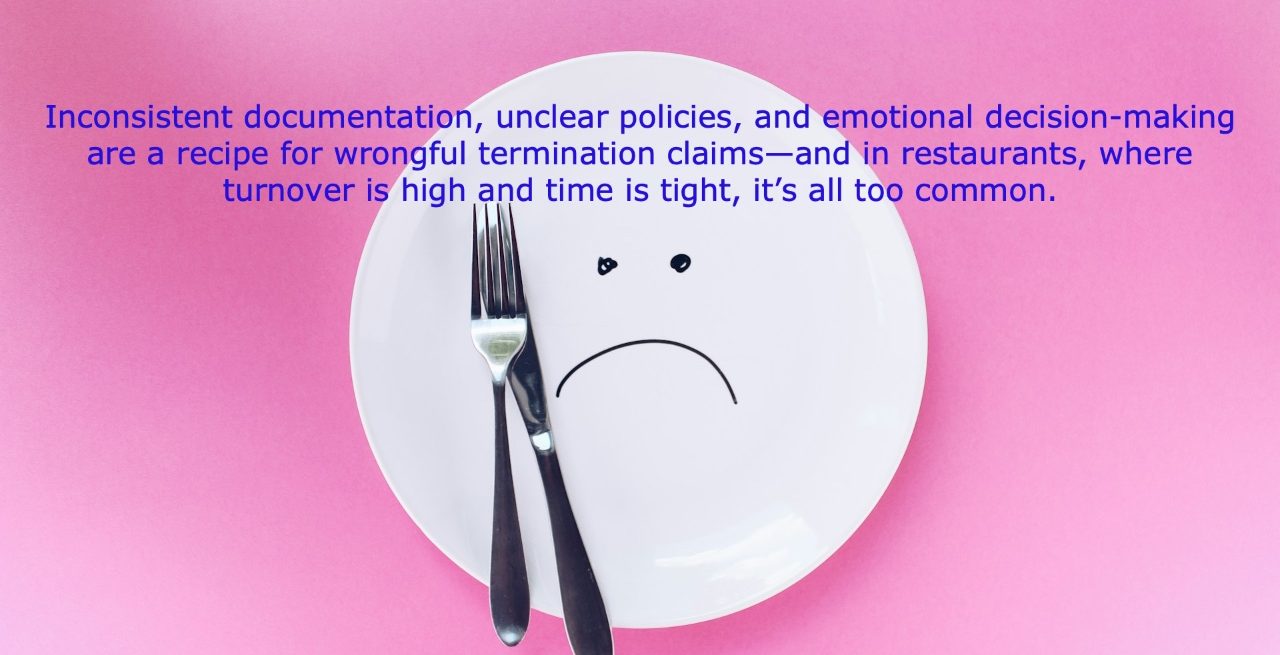Minimizing Wrongful Termination Claims
4 Min Read By Carrie Luxem
How operators can reduce risk with better documentation, consistent policies, and stronger training.
I’ll never forget this moment with one of my clients.
One of their general managers had just let go of a team member for repeated tardiness. On paper, it seemed like a slam dunk—the employee had been late 18 times in two months. But when I asked about the documentation, I got a sheepish shrug. “Well, we didn’t write her up every time,” the manager said. “But we talked about it a lot.”
Turns out, three other employees were just as late—and none of them had been disciplined. One of them was even getting promoted. You can guess how that story ended.
Inconsistent documentation, unclear policies, and emotional decision-making are a recipe for wrongful termination claims—and in restaurants, where turnover is high and time is tight, it’s all too common.
So how do you protect your business and treat your people fairly?
Here’s what every restaurant operator needs to know.
Wrongful Termination: What It Really Means
Let’s clear something up first.
Wrongful termination doesn’t mean “someone was fired and didn’t like it.”
It means they were terminated in a way that violated the law (discrimination, retaliation, etc.) or their legal rights under a contract or policy.
But even when a claim doesn’t hold legal weight, if it’s not handled right—it can turn into:
- A lawsuit
- A complaint to a labor board
- A hit to your culture and reputation
Bottom line: Employees don’t sue because they were let go. They sue because they feel blindsided, mistreated, or unheard.
Red Flags That Lead to Claims
In our work at Restaurant HR Group, we’ve seen the patterns. Here are a few things that consistently lead to trouble:
Lack of documentation: No written record of issues, conversations, or prior discipline
Inconsistent treatment: One person is terminated, another with the same behavior is not
Policy confusion: Outdated or unclear policies that don’t match what’s being enforced
Reactive terminations: Decisions made out of frustration, without HR input or prep
Documentation: Your Best Friend
Good documentation isn’t just a CYA move—it’s a communication tool.
Here’s what strong documentation looks like:
- Date and time of the incident
- Specific behavior observed
- Which policy was violated (cite the handbook if you have it!)
- Action taken and what was communicated to the employee
- Employee response or acknowledgment
And yes, verbal warnings should be documented too. A quick email or note-to-file is better than nothing.
Use a consistent form or template to simplify this process for your managers.
Consistency Is Everything
Let’s go back to that tardiness example.
If four team members are late the same number of times, but only one gets terminated, guess what that looks like? Discrimination.
Even if that wasn’t the intention.
You don’t need to treat every situation identically—but you do need a clear rationale for every decision.
So ask yourself:
- Did we give everyone the same expectations?
- Did we follow the same process with each person?
- Did we document everything the same way?
If not, pause. Reassess. And talk to HR before moving forward.
Train Managers to Handle Terminations the Right Way
One of the most powerful things you can do is coach your leaders on how to terminate professionally.
At Restaurant HR Group, we walk our clients through this all the time. Here’s a simple framework:
Before the Conversation:
- Review documentation
- Revisit company policies
- Double-check for consistency
- Plan what you’ll say (and what not to say)
During the Conversation:
- Keep it short, clear, and respectful
- Avoid over-explaining or placing blame
- Stick to the facts: “Due to continued policy violations, your employment is ending today.”
After the Conversation:
- Send a termination memo or follow-up email
- Secure final pay and offboarding materials
- Document that the conversation occurred
Even better? Practice with role-play scenarios before they’re needed.
When to Involve HR (or Legal)
Not every termination needs a legal review. But here are a few times to get backup:
- The employee has recently filed a complaint or requested leave
- You’re terminating someone in a protected category (age, disability, pregnancy, etc.)
- You feel unsure about your documentation
- The employee has threatened legal action
This is where HR earns its keep—and why many of our clients lean on us before making a final call.
If you’re thinking “this feels risky”… it probably is. Hit pause and ask for help.
What I Tell My Clients
Let me leave you with a few go-to reminders I share with restaurant leaders:
- Don’t delay documentation—start early, even if the issue seems minor.
- Policies aren’t just paper—they must be lived and enforced consistently.
- Be kind, but clear—letting someone go should be respectful, not apologetic.
- Role-play tough convos—your leaders should feel prepared, not panicked.
- The goal isn’t to avoid terminations—it’s to do them right.
Terminations are part of the job—but wrongful termination claims don’t have to be.
With consistent documentation, policy clarity, and confident leadership, you can protect your business, your people, and your peace of mind.
And remember: the goal isn’t to “win” every situation. It’s to lead with fairness, integrity, and professionalism—every single time.
Fair treatment isn’t a feeling—it’s a process. When your process is strong, your risk goes down and your leadership rises.


